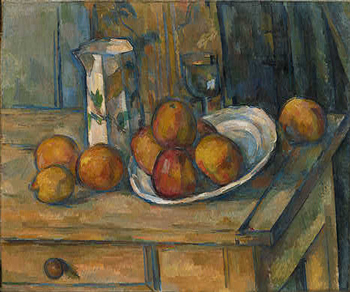| Search Art Prints | ||||||||||||||||||||
| Search Artists | ||||||||||||||||||||

|
||||||||||||||||||||
|
|
|||||||||||||||||||

Still Life with Milk Jug and Fruitalso known as Kettle Glass and Plate with Fruit, Still Life

|
Cézanne enjoyed painting still lifes, and he completed many during his long career (he occasionally remarked that fruit was perhaps his favorite subject). This image, one of his best-known still lifes, is also an excellent example of themes and techniques that typified his work of this variety.
From the 1880s onwards, all of Cézanne's still lifes featured shades of blue. Even when none of the objects present were blue, he would use dark shades of blue (and only blue) to render the shadows the objects cast. He usually employed a technique of painting the outlines of the shadows, then filling them in with light blues, then painting them over with darker hues, until the shadow began to take on a satisfactory character. He certainly utilized that technique here: even though it is hard to make out, the shadows to the right of the jug and the fruit are indeed blue. Beyond the shadows, though, blue rules the composition of the entire piece, with the objects essentially being presented against a blue backdrop.
The way Cézanne uses curves is typical of his other still lifes as well. Though the interaction of the curves of the fruit and, in particular, the opening of the jug, seem odd and even distorted from our perspective, there is a definite reason for it. Cézanne is bringing to a standstill those lines which suggest movement. He is discouraging the eye from moving along them, and in turn preventing the objects from being perceived as though in a state of change. Cézanne used this technique extensively, but it is particularly evident in still lifes such as this.











